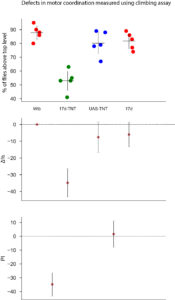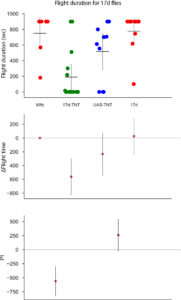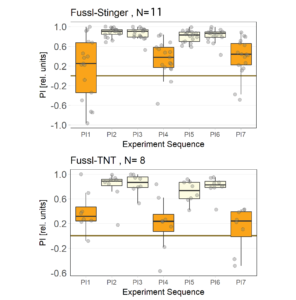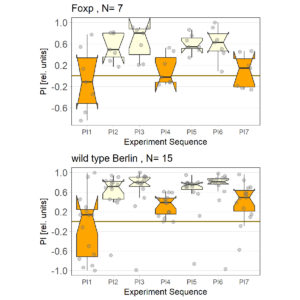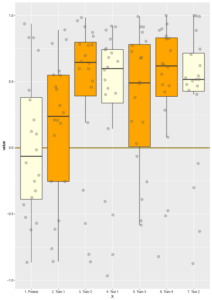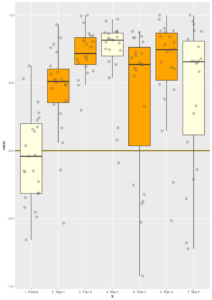17d flight simulator
on Monday, October 1st, 2018 2:58 | by Anders Eriksson
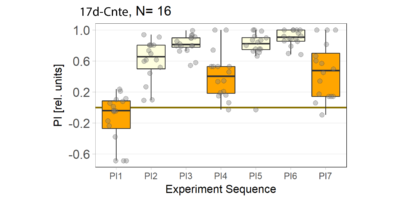
Category: crosses, flight, genetics, Memory, Operant learning, operant self-learning | No Comments
17d
on Monday, September 10th, 2018 1:03 | by Anders Eriksson
Been working on 17d for the past month.
The experiments in the flight simulator. Self-learning performance indices in a two-minute test with the heat switched off after 4 and 8 minutes of training, indicated impairment of 17d-TNT flies.

The flies also showed clear impairments in their flight performance. To quantify this I assessed both possible alterations in their motor coordination (using climbing assay) as well as flight performance. The climbing assay relies on walking rather than flying. Both experiments show reduced ability of motor coordination and flight performance.
To confirm the specificity of the 17d-Gal4 fly I used the trans-tango flies.

Neuron, 96 (2017) 783-799. doi:10.1016/j.neuron.2017.10.011
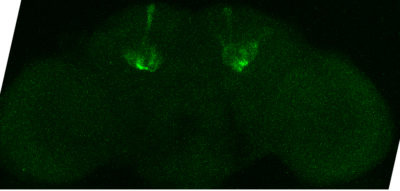
The trans-tango is notorious for having a low expression in adult flies, which was also observed by me. The image is taking without any GFP-antibody.
Category: Anatomy, crosses, flight, genetics, Memory, operant self-learning | No Comments
Fussl shows numerical difference in operant self learning
on Tuesday, August 7th, 2018 2:49 | by Anders Eriksson
Fussl was crossed with either Stinger (ctrl) or a UAS-TNT line to block the synaptric transmission of the Fussl positive neurons. A third construct was used but did not yield any data due to difficulties with their flight performance. The Fussl-Stinger along with Fussl-TNT flies do also show difficulties in flying. These differences will be assessed.
The experiment was done as a pilot experiment before doing a larger scale.
The data is a bit inconsistent but shows a positive and reassuring numerical difference. The control is a bit lower than expected, compared to WTB flies (showing usually a PI 0f 0.6). The flies have a slightly different background than wtb flies and have pale orange eyes (still no apparent impairments in vision). Further experiments will be conducted before proceeding with a larger sample size of the flies.
Category: crosses, flight, genetics, Lab, Memory, operant self-learning | No Comments
Assessing the difficulties in self-learning for FoxP flies
on Monday, July 30th, 2018 1:52 | by Anders Eriksson
FoxP3955 flies were raised and compared to normal WTB flies. Reportedly, the Foxp mutants have a reduced flight performance as their total flight duration is decreased. This was also something I experienced. The problem seemed to be greater due to the heat in the flight simulator room, initial temperature was 27°C but increased to close to 30°C. I had troubles getting a large sample size enough (same number of Foxp and wtb were loaded into the flight simulator), heat-shock proteins and other stress-related behavior might be an issue. The genotype of the flies were known during the hooking of the flies but was later on concelead and flies were randomly distributed. 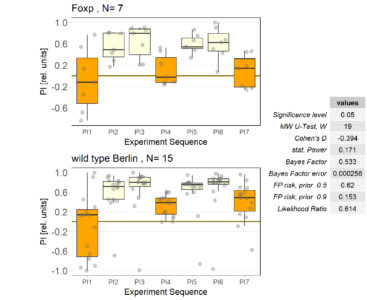
Category: flight, Foxp, Memory, operant self-learning | No Comments
Running the flight simulator analysis script
on Monday, July 2nd, 2018 1:55 | by Anders Eriksson
Category: flight, Lab, Memory, R code | No Comments
Wildtype flies and flight simulator Part 2
on Monday, June 11th, 2018 1:29 | by Anders Eriksson
Category: flight, Memory, R code, Uncategorized | No Comments
Wildtype flies and flight simulator
on Monday, June 4th, 2018 9:18 | by Anders Eriksson
Category: flight, Memory, R code | No Comments

